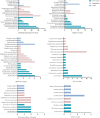Compositional and drug-resistance profiling of pathogens in patients with severe acute pancreatitis: a retrospective study
- PMID: 33261570
- PMCID: PMC7709241
- DOI: 10.1186/s12876-020-01563-x
Compositional and drug-resistance profiling of pathogens in patients with severe acute pancreatitis: a retrospective study
Abstract
Background: Infection is one of the important causes of death in patients with severe acute pancreatitis (SAP), but the bacterial spectrum and antibiotic resistance are constantly changing. Making good use of antibiotics and controlling multi-drug-resistant (MDR) bacterial infections are of vital importance in improving the cure rate of SAP. We conducted a retrospective study in the hope of providing references for antibiotic selection and control of drug-resistant bacteria.
Methods: Retrospective analysis was performed on the data of patients hospitalized in our hospital due to acute pancreatitis (AP) in the past 5 years. General data were classified and statistically analyzed. Subsequently, the bacterial spectrum characteristics and the data related to drug-resistant bacterial infection of 569 AP patients were analyzed. Finally, unconditional logistic regression analysis was conducted to analyze the risk factors of MDR infection.
Results: A total of 398 patients were enrolled in this study and the hospitalization data and associated results were analyzed. A total of 461 strains of pathogenic bacteria were detected, including 223 (48.4%) gram-negative bacterial strains, 190 (41.2%) gram-positive bacterial strains and 48 (10.4%) fungal strains. The detection rates of resistance in gram-negative and gram-positive bacterial strains were 48.0% (107/223) and 25.3% (48/190), respectively. There were significant differences between the MDR group and the non-MDR group for the factors of precautionary antibiotic use, kinds of antibiotics used, receipt of carbapenem, tracheal intubation, hemofiltration and number of hospitalization days in the intensive care unit. Unconditional logistic regression revealed 2 risk factors for MDR bacterial infection.
Conclusions: Our results illustrate that gram-negative bacteria were the most common pathogens in SAP infection, and the proportion of gram-positive bacteria increased notably. The rate of antibiotic resistance was higher than previously reported. Unconditional logistic regression analysis showed that using more types of antibiotics and the number of hospitalization days in the ICU were the risk factors associated with MDR bacterial infection.
Keywords: Antibiotic resistance; Bacteria spectrum; Multi-drug resistant bacteria; Risk factors; Severe acute pancreatitis.
Conflict of interest statement
The authors declare that they have no competing interests.
Figures






Similar articles
-
The impact of multi-drug resistant Pseudomonas aeruginosa infections on acute pancreatitis patients.BMC Infect Dis. 2023 May 22;23(1):340. doi: 10.1186/s12879-023-08230-y. BMC Infect Dis. 2023. PMID: 37217844 Free PMC article.
-
Infectious Complications in Severe Acute Pancreatitis: Pathogens, Drug Resistance, and Status of Nosocomial Infection in a University-Affiliated Teaching Hospital.Dig Dis Sci. 2020 Jul;65(7):2079-2088. doi: 10.1007/s10620-019-05924-9. Epub 2019 Nov 5. Dig Dis Sci. 2020. PMID: 31691173
-
Clinical study of distribution and drug resistance of pathogens in patients with severe acute pancreatitis.Chin Med J (Engl). 2012 May;125(10):1772-6. Chin Med J (Engl). 2012. PMID: 22800898
-
Cefiderocol: A Siderophore Cephalosporin with Activity Against Carbapenem-Resistant and Multidrug-Resistant Gram-Negative Bacilli.Drugs. 2019 Feb;79(3):271-289. doi: 10.1007/s40265-019-1055-2. Drugs. 2019. PMID: 30712199 Review.
-
Choice of therapeutic interventions and outcomes for the treatment of infections caused by multidrug-resistant gram-negative pathogens: a systematic review.Antimicrob Resist Infect Control. 2019 Nov 4;8:170. doi: 10.1186/s13756-019-0624-1. eCollection 2019. Antimicrob Resist Infect Control. 2019. PMID: 31709047 Free PMC article.
Cited by
-
Characteristics of and risk factors for biliary pathogen infection in patients with acute pancreatitis.BMC Microbiol. 2021 Oct 5;21(1):269. doi: 10.1186/s12866-021-02332-w. BMC Microbiol. 2021. PMID: 34610799 Free PMC article.
-
Risk Factors for Mortality Among Critical Acute Pancreatitis Patients with Carbapenem-Resistant Organism Infections and Drug Resistance of Causative Pathogens.Infect Dis Ther. 2022 Jun;11(3):1089-1101. doi: 10.1007/s40121-022-00624-w. Epub 2022 Apr 4. Infect Dis Ther. 2022. PMID: 35377132 Free PMC article.
-
Efficacy of Graded Emergency Nursing on Acute Pancreatitis Patients: A Meta-Analysis.Iran J Public Health. 2021 Jun;50(6):1097-1107. doi: 10.18502/ijph.v50i6.6409. Iran J Public Health. 2021. PMID: 34540731 Free PMC article. Review.
-
Identification and characterization of pancreatic infections in severe and critical acute pancreatitis patients using 16S rRNA gene next generation sequencing.Front Microbiol. 2023 Jun 14;14:1185216. doi: 10.3389/fmicb.2023.1185216. eCollection 2023. Front Microbiol. 2023. PMID: 37389346 Free PMC article.
References
-
- Ma HX, He L, Cai SW, Xin XL, Shi HD, Zhou L, et al. Analysis of the spectrum and resistance of pathogen causing sepsis in patients with severe acute pancreatitis. Zhonghua wai ke za zhi [Chinese journal of surgery] 2017;55:378–383. - PubMed
MeSH terms
Substances
LinkOut - more resources
Full Text Sources
Medical
Miscellaneous

